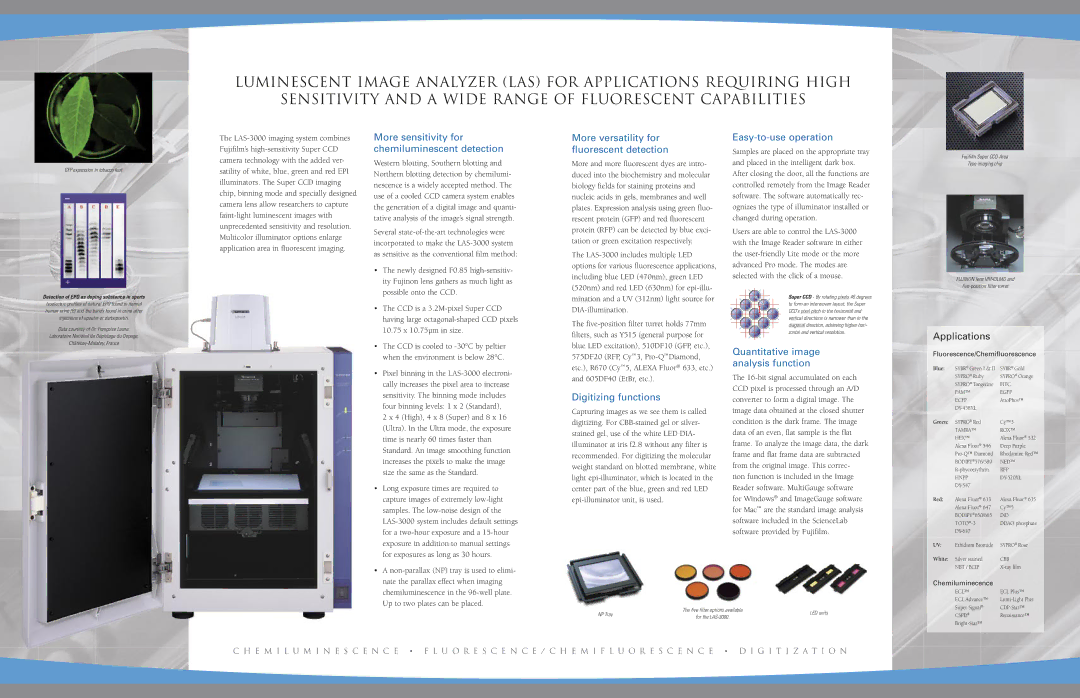
Luminescent image analyzer (LAS) for applications requiring high
sensitivity and a wide range of fluorescent capabilities
GFP expression in tobacco leaf
Detection of EPO as doping substance in sports Isoelectric profiles of natural EPO found in normal human urine (B) and the bands found in urine after injections of epoetin or darbepoetin.
Data courtesy of Dr. Françoise Lasne.
Laboratoire National de Dépistage du Dopage,
The
More sensitivity for chemiluminescent detection
Western blotting, Southern blotting and Northern blotting detection by chemilumi- nescence is a widely accepted method. The use of a cooled CCD camera system enables the generation of a digital image and quanti- tative analysis of the image’s signal strength.
Several
•The newly designed F0.85
•The CCD is a
•The CCD is cooled to
•Pixel binning in the
2 x 4 (High), 4 x 8 (Super) and 8 x 16 (Ultra). In the Ultra mode, the exposure time is nearly 60 times faster than Standard. An image smoothing function increases the pixels to make the image size the same as the Standard.
•Long exposure times are required to capture images of extremely
•A
More versatility for fluorescent detection
More and more fluorescent dyes are intro- duced into the biochemistry and molecular biology fields for staining proteins and nucleic acids in gels, membranes and well plates. Expression analysis using green fluo- rescent protein (GFP) and red fluorescent protein (RFP) can be detected by blue exci- tation or green excitation respectively.
The
The
Digitizing functions
Capturing images as we see them is called digitizing. For
Easy-to-use operation
Samples are placed on the appropriate tray and placed in the intelligent dark box. After closing the door, all the functions are controlled remotely from the Image Reader software. The software automatically rec- ognizes the type of illuminator installed or changed during operation.
Users are able to control the
Super CCD - By rotating pixels 45 degrees to form an interwoven layout, the Super CCD’s pixel pitch in the horizontal and vertical directions is narrower than in the diagonal direction, achieving higher hori- zontal and vertical resolution.
Quantitative image analysis function
The
Fujifilm Super CCD Area
Type imaging chip
FUJINON lens VRF43LMD and
Applications
Fluorescence/Chemifluorescence
Blue: | SYBR® Green I & II | SYBR® Gold |
| SYPRO® Ruby | SYPRO® Orange |
| SYPRO® Tangerine | FITC |
| FAM™ | EGFP |
| ECFP | AttoPhos™ |
|
| |
Green: | SYPRO® Red | Cy™3 |
| TAMRA™ | ROX™ |
| HEX™ | Alexa Fluor® 532 |
| Alexa Fluor® 546 | Deep Purple |
| Rhodamine Red™ | |
| BODIPY®576/589 | NED™ |
| RFP | |
| HNPP | |
|
| |
Red: | Alexa Fluor® 633 | Alexa Fluor® 635 |
| Alexa Fluor® 647 | Cy™5 |
| BODIPY®650/665 | DiD |
| DDAO phosphate | |
|
| |
UV: | Ethidium Bromide | SYPRO® Rose |
White: | Silver stained | CBB |
| NBT / BCIP |
Chemiluminecence
ECL™ | ECL Plus™ |
ECL Advance™ | |
® |
|
NP Tray | The five filter options available | LED units | |
for the | |||
|
|
Super Signal | |
CSPD® | Renaissance™ |
|
C H E M I L U M I N E S C E N C E • F L U O R E S C E N C E / C H E M I F L U O R E S C E N C E • D I G I T I Z A T I O N
